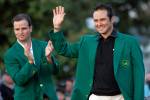Three guest artists team for stellar philharmonic outing
Three guest artists played prominent roles in the Las Vegas Philharmonic’s third
Masterworks Program of the season on Saturday. The chair of concertmaster DeAnn Letourneau, who was otherwise committed for the evening, was ably occupied by Martha Gronemeier who stepped in to take on the responsibility of leading the violin section and did so with aplomb.
Guest conductor Donato Cabrera made a return to the Las Vegas podium, tackling a program that holds countless challenges for a conductor. Cabrera met — and overcame — those challenges handily.
But the evening’s guest artist, violinist Alina Ming Kobialka, gave a clinic in technique that left the large Reynolds Hall audience wildly enthusiastic and calling for more, which Kobialka provided — but more about that later.
The programmed work was Felix Mendelssohn’s “Violin Concerto in E minor,” his only concerto for the violin. The concerto, which took the composer nearly five years to complete, is a tour de force that rivals Beethoven and is successfully presented only by the most highly skilled performers, both technically and artistically. Others may try but probably without satisfactory results.
Kobialka’s dazzling technique was not limited to finger dexterity. She also showed a superbly delicate touch for harmonics — notes in the extremely high register produced not by depressing the string but by barely touching it in exactly the right place to produce overtones.
The concerto is performed without the customary break between movements. The first movement features a solo cadenza, not at the movement’s close but before the restatement of the main theme, giving the impression that the violin accompanies the orchestra instead of the other way around. The two later movements lead to a conclusion of irresistible verve and drive.
Cabrera set tempos of motion and life, but only once, briefly, did the orchestra cover the soloist.
Kobialka responded to the audience’s rhythmic clapping with an unaccompanied encore, again a technical masterpiece reminiscent of Nicolo Paganini. Instead it was a traditional Chinese piece originally intended for pipa and transcribed for violin. It paid homage to the artist’s ethnic heritage.
Kobialka is not yet 20. Watch for her name. She appears to be bound for greatness.
Following intermission, Las Vegas heard, for the first time, a work titled “Equus” by Eric Whitacre. The composer is a graduate of the University of Nevada, Las Vegas and now is serving as composer in residence at Sidney Sussex College of Cambridge University in England. Cabrera took “Equus” at a fast clip which made its almost constantly shifting rhythmic patterns both effective and demanding of the listener. There were a few similarities to “Dance at the Gym” from Bernstein’s “West Side Story” — but only similarities, not lifts. “Equus” was written originally for wind ensemble and, while brilliantly effective for orchestra, one can but imagine its power when done by a wind band. We can hope the piece makes its way eventually into the standard repertoire. It merits that.
The evening began and ended with two musical seascapes. Opening the program was the somewhat lesser known of the two, Benjamin Britten’s four “Sea Interludes” from his first full-scale opera, “Peter Grimes.” The interludes introduce each act and link the separate scenes. They provide the setting of the sea and its many moods.
The first, “Dawn,” portrays early morning by the seashore. The second, “Sunday Morning,” establishes a festive Sabbath mood. The third is “Moonlight.” Its mood is lonely and dark. The fourth interlude is “Storm” which depicts roaring wind and sea.
Most (but not all) performances include a fifth piece, a passacaglia, which ties together the first four interludes. It was not included in Saturday’s program.
Bringing the evening to a close was Claude Debussy’s tonal portrait, “La Mer.” He originally titled it “Three Symphonic Sketches” and perhaps it should have remained so since it relies so much on suggestion and subtlety. It was well performed, but not as communicative as the two centerpieces, “Equus” and the Mendelssohn concerto.
Cabrera cuts a commanding figure on the podium but his conducting style is not overbearing. It’s apparent the players like him. With him in the running for the top job here in Las Vegas, the eventual decision will not be an easy one to make.























